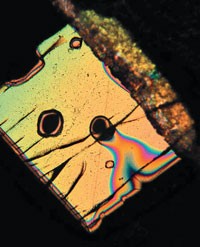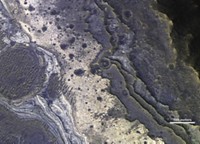Advertisement
Grab your lab coat. Let's get started
Welcome!
Welcome!
Create an account below to get 6 C&EN articles per month, receive newsletters and more - all free.
It seems this is your first time logging in online. Please enter the following information to continue.
As an ACS member you automatically get access to this site. All we need is few more details to create your reading experience.
Not you? Sign in with a different account.
Not you? Sign in with a different account.
ERROR 1
ERROR 1
ERROR 2
ERROR 2
ERROR 2
ERROR 2
ERROR 2
Password and Confirm password must match.
If you have an ACS member number, please enter it here so we can link this account to your membership. (optional)
ERROR 2
ACS values your privacy. By submitting your information, you are gaining access to C&EN and subscribing to our weekly newsletter. We use the information you provide to make your reading experience better, and we will never sell your data to third party members.
Physical Chemistry
Seeking Chemical Clues To Earthquakes
Scientists are drilling miles into Earth to probe the chemistry and mechanics of the San Andreas Fault
by Elizabeth K. Wilson
January 23, 2006
| A version of this story appeared in
Volume 84, Issue 4
On the surface, Parkfield, Calif., looks unremarkable. With a population of 18, the town consists of a few homes, a café, and a rustic inn with a sign urging visitors, "Sleep here when it happens."
What happens in Parkfield? Earthquakes. On a regular basis.
The town lies just east of the central California coast, smack dab on the San Andreas Fault, the boundary between tectonic plates that stretches 800 miles through the state. The fault has produced some devastating quakes, including the 1989 Loma Prieta quake and the 1906 San Francisco quake. But this particular section of the fault, which geologists refer to as an "earthquake machine," is beset by frequent, shallow microquakes of around magnitude 2. Moderate-sized temblors punctuate this rumbling with remarkable regularity, on average every 22 years. The last one, a magnitude 6, occurred in September 2004.
This unusual geological activity, reflected in the wild, chunky landscape, has made the area a locus for seismic study: It's the most heavily instrumented earthquake zone in the world.
Last August, the U.S. Geological Survey (USGS) finished drilling a 2-mile-deep hole through the guts of the fault near Parkfield. The project, known as the San Andreas Fault Observatory at Depth, or SAFOD, aims to answer the weighty questions of how and why earthquakes happen there.
Scientists have drilled into other faults around the world following major quakes, such as the 1995 Kobe earthquake on the Nojima Fault in Japan and the 1999 Chi-Chi quake along the Chelungpu Fault in Taiwan. But SAFOD is unique in that the fault under scrutiny is regularly, frequently active, giving scientists a chance to study it immediately before, during, and after quakes. "We can now conceive of experiments we've never conceived of before," says Mark D. Zoback, geology and geophysics professor at Stanford University and coprincipal investigator for SAFOD.
It's perhaps surprising that chemistry, a molecular-scale science, plays a large role in the global-scale phenomenon of earthquakes. In addition to measuring mechanical properties such as stress and pressure, a number of SAFOD experiments focus on the chemistries of fault fluid, minerals, and gases. From these chemistries stem rock alterations, pressure buildups, and frictional changes that may eventually lead to earthquakes.
The ultimate goal, of course, is to predict when earthquakes will occur, before they decimate cities like Los Angeles or Mexico City. But first, scientists have to determine whether it's even possible to get a complete handle on such complex systems. Earthquake predictions, which have been based on measurements taken at Earth's surface, so far have largely been a failure. For example, the clockwork regularity of Parkfield earthquakes, as well as an increase in microquakes there in the mid-1980s, led scientists to predict that the next earthquake would occur no later than 1993. Instead, it occurred 11 years later.
SAFOD's proximity to the geological action makes it possible to imagine that one day earthquakes might be fully understood. "We'll never be closer than we are with SAFOD," says Stephen Hickman, a geophysicist at USGS in Menlo Park, Calif., and one of the principal investigators of the project.
Early results from both a pilot hole and the freshly drilled main hole, reported at the American Geophysical Union meeting in San Francisco last month, show that the area around the San Andreas Fault is even more complicated than previously thought, layered with alternating bands of minerals and shot through with small adjacent faults.
The San Andreas Fault also appears to act as a barrier, impeding the flow of fluid and gas between two tectonic plates known as the Pacific and North American plates.
Twenty million years ago, the area was a subduction zone, with the Farallon plate lying between the Pacific and North American plates and sinking underneath the continent. Now, the western Pacific plate grinds inexorably northwest past the North American plate. Yet for all that friction, there's almost no detectable heat being generated. One of SAFOD's goals is to find the reason for this so-called heat-flow paradox. One theory holds that fluid may build up to high pressures, then break through sealed cracks in the rocks, thereby causing an earthquake.
The SAFOD project's quest to solve these mysteries began in 2002 with the drilling of the pilot hole 1.4 miles deep to the west of the fault. In 2004, engineers tackled the main SAFOD hole, adjacent to the pilot hole, drilling down 1.3 miles into the Pacific plate, then east at a 55o angle another mile through the fault zone into the North American plate.
Oil-drilling technology made the arduous project possible. May through August 2004 was a chaotic period of deafening generators and round-the-clock drilling. According to those involved in the project, the football-field-sized drilling area morphed into an ersatz campground, crowded with trailers and equipment and scientists frantically gathering data and samples as fast as the drill worked itself downward.
A special clay-mineral-based mud having the proper density to stabilize the hole circulated through it, lubricating the drill and bringing up pulverized material. This particular mud was unlikely to react chemically with any of the minerals, gases, and fluids from the core. The circulating mud, which took 10 minutes to return to the surface, was collected in a box, whimsically known as a "possum belly" (the name's origin is unknown). The rock chips were then filtered out, gas bubbles were removed, and the mud was sent back into the hole.
Thomas Wiersberg, a geochemist from GeoForschungsZentrum in Potsdam, Germany, was constantly sampling borehole gases such as carbon dioxide, hydrogen, helium, and radon during the drilling. He managed to escape his trailer only when drilling stopped for quick repairs, and he would rush into the nearby town of Paso Robles for food and supplies. "We had a lot of interesting gas hits but not so much sleep," he says.
To add to the excitement, as workers angled the main hole downward, they accidentally bumped into the pilot hole and caused a tear partway down. The tear was sealed up with concrete, but access to the pilot hole was truncated at that location.
The SAFOD site is much calmer now. The drilling rig has been dismantled, and only a few trailers remain while a handful of scientists wrap up experiments. Over the next year-and-a-half, using the 2-mile-deep hole, they'll be installing an array of instruments directly inside the zone where the microquakes are produced. The scientists will be looking at rock cores for evidence of chemical precipitation and anomalous minerals that could plug fissures. By 2007, they'll be able to sample whole, undisturbed cores, like the plugs taken from an aerated lawn, that will give a much clearer picture of the mineralogical structure in the fault.
For example, the dissolved minerals circulating in water through the rocks could be key to the earthquake process. The precipitation of quartz, feldspar, and other minerals may plug cracks and pores, and the greater the depth and the higher the temperature, the faster the process becomes, Hickman says. During earthquakes, fluid may break through these mineral seals. "We see lots of evidence for multiple episodes of chemical sealing, then reopening of fractures," Hickman says. The cores that will be sampled in 2007 should shed light on the role of dissolved minerals.
In the meantime, the samples the researchers have already collected are yielding new information. Gases, normally dissolved at the high pressures and temperatures inside a fault, are very good tracers of fluid flow inside Earth. The isotopic ratios of helium, for example, vary greatly between the mantle and the crust, the mantle having an extremely high ratio of 3He to 4He. On the Pacific plate side, helium isotope ratios indicate that the gas came from the crust. But on the other side, some of the helium also comes from the mantle. That suggests that the fault is preventing the migration of materials from one plate to the other.
Oxygen, too, shows isotopic variation. James J. Thordsen, a USGS geologist, notes that water on the east side of the fault is enriched in the heavier isotopes of oxygen. "That suggests a different origin," he says.
Other gases provide clues to the origin of fluids. Methane by itself is a good marker of microbial activity. A mix of hydrocarbons such as methane, ethane, and propane, on the other hand, would likely be produced from ancient organic sediments that have undergone reactions deep inside Earth. As expected, Wiersberg found biogenic methane at shallow depths, whereas at deeper depths, the gases were almost purely derived from organic sediments.
What did surprise geologists, he says, was the high concentration of hydrogen. The source, he hypothesizes, might be water's interaction with newly, seismically disturbed rocks.
Scientists had hoped to find evidence of high-pressure fluids in the core fault zone, which would help explain why the fault seems to slip so frictionlessly. But they didn't. "In fact, we don't seem to have found any," Zoback says. Solving that mystery may also have to wait until the next phase of the project in 2007.
One thing won't wait, and that's the San Andreas Fault. As it continues to creep, the steel core that was driven into it at Parkfield is beginning to deform. The tube is already offset by about 4 mm. In a few years, the fault's progress will shear the steel tube, although the new set of probes yet to be installed won't be affected. It's something SAFOD scientists anticipated, but it means that their window is limited. "We will have to hurry to use the existing hole in the next couple of years," Zoback says.









Join the conversation
Contact the reporter
Submit a Letter to the Editor for publication
Engage with us on Twitter